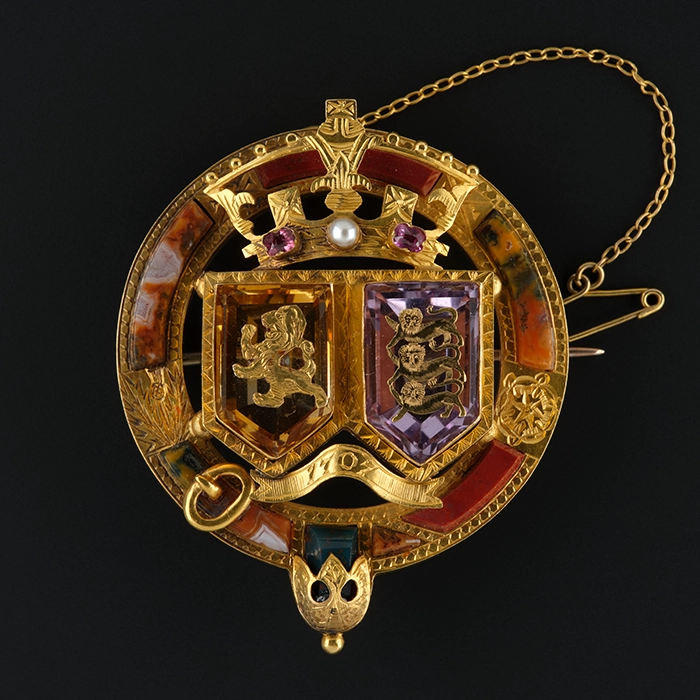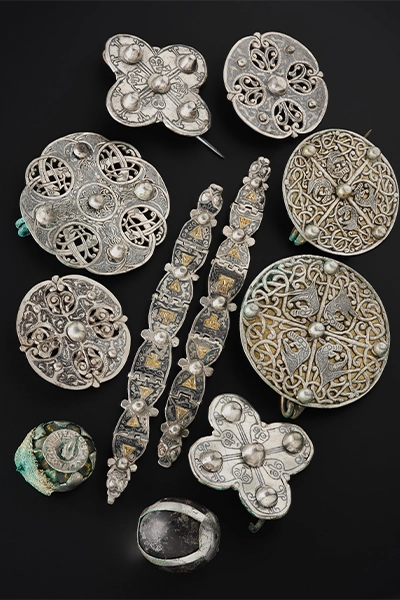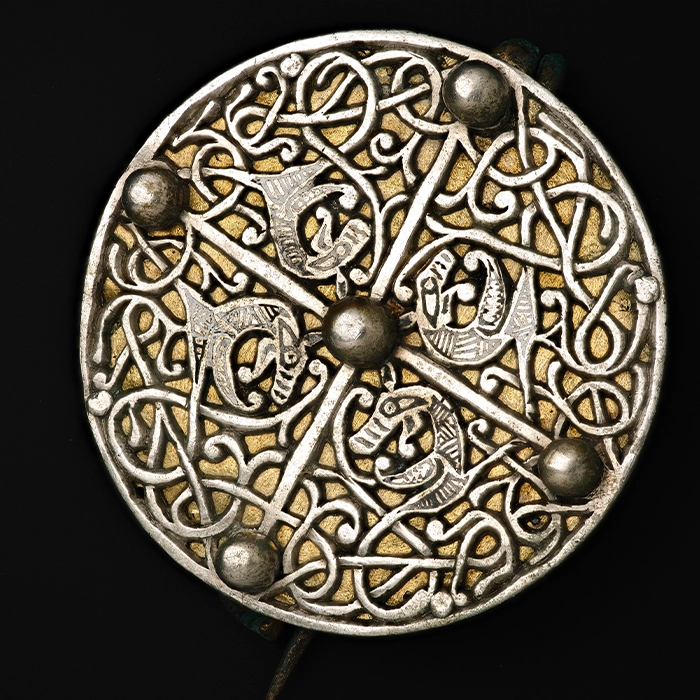28 October 2024
Myth-busting Scotland’s jewellery
8 minutes
English writer and philosopher John Ruskin described Scotland as ‘a magnificent mineralogical specimen’. He was right, Scotland’s rare natural resources are of a special quality – sapphires on the Isle of Harris, amethysts from Galloway, quartz from Perthshire, agate from north of Dundee – and river pearls coveted by the Romans.
In fact, when Julius Caesar invaded Britain, he was keen to conquer Scotland for its freshwater river pearls.
Celtic jewellery expert Clare Blatherwick, who is based in North Berwick, says that since the Romans, Scotland’s jewellery has been of exceptional quality.
|
(Image: Union Brooch. Credit: National Museums Scotland) |
She said: “So often when people think about Scottish jewellery it will be Victorian ‘pebble’ jewellery but many of the gems are spectacular. We have stunning, distinctive agates and Blue Hole Agate, from south of Montrose, which are a brilliant inky deep blue and white while the Burn Anne stream, in Ayrshire, has provided a large quantity of beautiful, coloured agate which has a distinctive orbicular pattern.” “We also have Elie Rubies. They're actually garnets but you can walk along the beach at Elie Bay, on the East Fife coast, and pick them up from the sand.” FRESHWATER PEARLS Scotland’s river pearls feature in the Honours of Scotland, the Scottish crown jewels, which include the oldest crown in the British Isles. They can be seen in Edinburgh Castle’s Crown Room. Made of Scottish gold, silver and precious gems, the crown, sceptre and sword of state are objects of immense significance. The crown was made for James V, who first wore it at the coronation of his Queen, Mary of Guise, at Holyrood Abbey in 1540. Scottish pearls often have terracotta and brown hues or they can be quite blue with violet shades. It's unusual to find them perfectly round and the lustre is slightly different to a saltwater pearl because of the environment in which they've grown. The pearl-producing mussels, Margueritafera Margueritafera, are now protected. Anyone buying Scottish pearls should be sure to use a licensed dealer and buyers should ask for proof that the pearl was fished before 1987. Clare Blatherwick explains why the mussel has been protected: “The Margueritafera Margueritafera adult female will produce something like 200 million spat in her lifetime but only two will survive. When they're released into the water they have got to find a salmon or a trout to hang onto the gills for a season before they land on sand or gravel. If the landing spot is not perfectly clean, if there are pollutants or the water's not the right temperature, they will not survive. That’s why they are so rare and need protection. “Centuries back, skilled fishermen would inspect the mussel and if the pearl was too small they would close it and put it back so the mollusc would survive. Once people could drive into the Highlands, careless poachers would just rip up and decimate the pearl beds. Some people still know where the pearl beds are, but it's a well-kept secret.” |
|
SILVER The Romans brought silver to Scotland, at first giving locals coins and trinkets, and later, sections of silver from objects like vases or trays – it's called hack silver. Clare says locals couldn't spend the silver but they knew they were prestige objects so they began to break it up and melt it. She said: “By the 4th and 5th centuries, Scots started to use the silver to make huge chains made of undiluted Roman silver.” The National Museum of Scotland, in Edinburgh, houses some of the finest examples of these chains and exceptional silver jewellery: The Hunterston BroochSilver was also re-used to make exquisite jewellery. The Hunterston Brooch is one of the finest pieces from the 8th century, found on the West Coast of Ayrshire. It has intricate filigree work and contains amber from the Baltic which demonstrates the international trade at that time. This penannular brooch is a design we continue to see to this day. The Galloway HoardBuried around 900AD, the Galloway Hoard, found in Dumfriesshire, near Kirkcudbright, includes disc brooches with little spheres that make them look like a shield. The hoard contains Anglo-Saxon Scottish brooches in unusual designs including a quatrefoil and one brooch shows men’s faces; two blowing horns and another two holding their ears to protect themselves from the noise. (Image: Anglo-saxon metalwork from inside the lidded vessel from the Galloway Hoard. Credit: National Museums Scotland) |
|
|
|
St Ninian’s HoardFound on St Ninian’s Isle, Shetland, this hoard from the second half of the 8th century contains silver and silver gilt treasures and some are thought to be Pictish (in the early Middle Ages the Picts lived north of the Firth of Forth). The hoard also includes 12 elaborate brooches which would signify they were owned by an aristocratic household. Here, the silver has been diluted so it’s interesting that it started to be stretched with other metal added to it to create an alloy. Silver at the time of the Romans, was valued more than gold. The Brooch of LornThe Brooch of Lorn, a silver disc brooch with extended spheres, was always thought to belong to Robert the Bruce but its construction dates to the 16th century. The central rock crystal is earlier and feasibly could have a connection to Bruce. Queen Victoria was shown the brooch and Prince Albert had a replica made for her in gold but when their daughter Princess Louise married the Marquess of Lorne she received the original brooch as a wedding present. The Lochbuie Brooch Set with Scottish pearls and rock crystals this ring brooch probably dates from the 12th-13th century. It is turreted and it is in a style that you might see in contemporary versions today. (Image: Disc brooch from the Galloway Hoard. Credit: National Museums Scotland) |
|
GOLD FEVER In the 1860s, there was a gold rush in the Highlands, not on such a scale as the American gold rush, but it happened. The last active gold mine in Cononish, near Tyndrum, Stirling, stopped production in early 2023 and closed at the end of the year. Clare said: “While the last mine has closed we do have gold in the hills, but it's a difficult landscape to excavate. However, when it comes out it usually has a really high yield per tonne compared to Africa, Australia or North America. “We do get people panning for gold as it is so fine; it has a particular colour – quite buttery and rich. Again, in the National Museum of Scotland, visitors can see wonderful examples of gold and historic jewels including an ingot of gold from Callacher Burn, Perthshire and the gold Sutherland Brooch, from north of Inverness, which contains Scottish pearls and quartz. It was made by Glasgow Jewellers Muirhead and Son around the 1870s.” (Image: Sutherland Brooch. Credit: National Museums Scotland) |
|
The Fettercairn Jewel
This rare locket was found at Fettercairn House in the back of the drawer when the Forbes family were clearing out goods to sell. It sold at auction in 2017. Clare got to handle the jewel before it went under the hammer for £236,750, bought by National Museums Scotland (NMS), which houses the world’s largest collection of Scottish Renaissance jewellery.
Clare said: “This was a very important addition to a very small pool of surviving Renaissance jewels in Scotland. Invaluable research is being carried out by NMS and should yield fascinating results.”
In fact, a new book, Decoding the Jewels, edited by Dr Anna Groundwater, Principal Curator, Renaissance and Early Modern History at the NMS, was inspired by the acquisition of the Fettercairn Jewel. The fine iconography of this exquisitely enamelled locket held coded messages for its 16th century owners and continues to intrigue people today given the rare survival of such jewels.
Dr Groundwater said: “The Fettercairn Jewel is a staggering piece because its dimensions are really small and the fineness of the enamelled imagery demonstrates the work of a stellar craftsman. When I watch people in the museum galleries, they're absolutely entranced because it's so tiny. It draws people in; they’re intrigued by its size, its beauty, the fine work and how intriguing it is because we don't quite know its message.”
Elite Renaissance men and women commissioned, wore and gifted intricate and valuable pieces of jewellery. They were mainly used to communicate messages and display status, intimate personal possessions with meanings invested in them by their owners.
Dr Groundwater explains: “On the front of the Fettercairn Jewel is a big red garnet surrounded by some fine enamelling while on the back is an enamelled scene of the god Mercury walking from left to right across the jewel. It's clearly marking a moment, a transition in someone's life. So whether that is simply a marriage or a commemorative piece for someone going from life to death, we do not know. That's really the marvel of this piece, it's very enigmatic and it's holding its secrets.
“Inside would have been miniature portrait and the identity of the person would give us, almost certainly, the reason why it was made. But we do not have that key evidence. We've done a lot of provenance work and what we are absolutely clear on is that it was made in the 1570s or 1580s. It could have been made in Britain and may well have been in Scotland for a very, very long time, we simply don't know.
“Certainly the quality of Scottish jewellery during the Renaissance period was on a level with the big jewellery making cities such as Paris and London. We don't have evidence to show the Fettercairn Jewel was made in Scotland but we do know that these kind of pieces were circulating in the country. As an example, the Penicuik Jewels, three lockets and a necklace of filigree gold beads, we have good provenance that two of them belonged to Mary Queen of Scots.”
About Clare Blatherwick
Clare Blatherwick spent 10 years as the Head of Jewellery for Bonhams, Scotland, sourcing pieces around the globe for auction and advising sellers, collectors and buyers. In 2017 she established her eponymous business, based in North Berwick, but continues to help clients globally. She offers highly personalised services, from insurance valuations to bespoke jewellery design and also sources antique and modern jewels.
Visit clareblatherwick.co.uk
About Dr Anna Groundwater
As Principal Curator of Renaissance and Early Modern History at NMS, Dr Groundwater is responsible for the collections of the material culture and history of Scotland from 1450-1750. This encompasses the Scottish Renaissance, applied arts, Scottish weaponry, early modern history, society and culture.
Visit nms.ac.uk
Decoding the Jewels: Renaissance Jewellery in Scotland, paperback ISBN: 9789464262575 | Hardback ISBN: 9789464262582
Sidestone Press, published with National Museums Scotland.
Visit sidestone.com/books/decoding-the-jewels
Jewellery Insurance
Whether you are a long-term collector or new to buying jewellery, remember the importance of regular valuations. Professional jewellery valuations are vital, especially as market rates for precious metals and stones fluctuate quickly.
Insurers recommend that you obtain a jewellery valuation at least every five years, preferably three in today’s market. But check your schedule and policy wording for specific requirements.
Insurers will require any valuation to be for “insurance purposes” and for retail value. You should also consider how you would replace your jewellery in the event of a loss. Would you want a brand new replacement with a modern equivalent (New Replacement Value), second hand replacement value (which can be more than the retail value if there’s a waiting list for a piece) or would you prefer an antique replacement (Antique Replacement Value)?
Ensure the items are photographed, kept in good condition and your documentation is in a safe place to help in the event of a claim. It’s a good idea to send a copy of your valuations to your broker, whether or not the insurer requires it.
Howden are specialists in finding jewellery insurance solutions, something you should never have to do on your own. We can point you in the direction of trusted valuation experts and then arrange a policy which will protect your passion and investment.
To speak to Alexandra about insuring your jewellery call 07464 545648 or email alexandra.richards@howdeninsurance.co.uk




